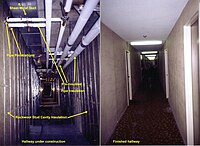
Pulverization of fibrous mineral wool waste
Sign Up to like & getrecommendations! Published in 2018 at "Journal of Material Cycles and Waste Management"
DOI: 10.1007/s10163-017-0692-3
Abstract: The total annual volume of mineral wool waste in the 27 European Union countries is expected to increase to 2.5 million tons per year by 2020. Unfortunately, mineral wool wastes are often considered unrecyclable, because their… read more here.
Keywords: mineral wools; wool; pulverization fibrous; wool waste ... See more keywords

Wool waste used as sustainable nonwoven for building applications
Sign Up to like & getrecommendations! Published in 2021 at "Journal of Cleaner Production"
DOI: 10.1016/j.jclepro.2020.123905
Abstract: Abstract Reusing textile waste in building applications has the potential to reduce the environmental impact of two sectors considered the main sources of environmental pollution: the textile and the construction industries. Thus, the main goal… read more here.
Keywords: waste; used sustainable; building applications; waste used ... See more keywords

Melting behaviour of raw materials and recycled stone wool waste
Sign Up to like & getrecommendations! Published in 2018 at "Journal of Non-crystalline Solids"
DOI: 10.1016/j.jnoncrysol.2018.01.035
Abstract: Abstract Stone wool is a widely used material for building insulation, to provide thermal comfort along with fire stability and acoustic comfort for all types of buildings. Stone wool waste generated either during production or… read more here.
Keywords: stone wool; charge; wool waste;

Utilization of keratin hydrolysate of wool waste fiber for free-salt dyeing of viscose fabric
Sign Up to like & getrecommendations! Published in 2022 at "Journal of Engineered Fibers and Fabrics"
DOI: 10.1177/15589250221097079
Abstract: Viscose dyeing is one of the major pollutants of water due to the large amount of salt in the dyeing effluent. This study paves the way for improving environmentally sustainable wool waste and highlights a… read more here.
Keywords: keratin hydrolysate; wool waste; spectroscopy; salt dyeing ... See more keywords

A Newly Isolated Strain Lysobacter brunescens YQ20 and Its Performance on Wool Waste Biodegradation
Sign Up to like & getrecommendations! Published in 2022 at "Frontiers in Microbiology"
DOI: 10.3389/fmicb.2022.794738
Abstract: Wool keratin is difficult to degrade as comparing to feathers because of its tough secondary structure. In order to develop an approach for high-value utilization of wool fiber waste by keratinolytic microorganisms, which is produced… read more here.
Keywords: brunescens yq20; lysobacter brunescens; wool waste; waste ... See more keywords